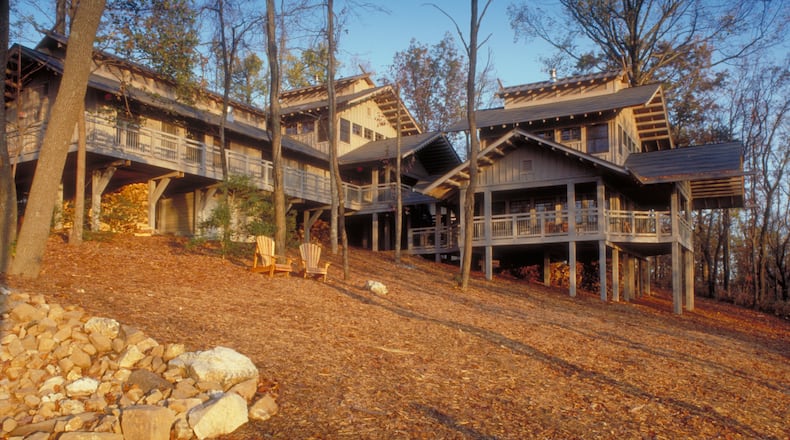Sometimes you want to get away — and sometimes you really want to get away.
Understandably so, given how the events of the past few years have led more people to seek escapes that provide them with plenty of personal space. Fortunately, in Georgia and beyond, there’s no shortage of remote vacation destinations that can help you unplug and get away from it all. Some are more remote than others, with accommodations that run the gamut from primitive camp sites to isolated luxury resorts. But in any case, you’ll be leaving the crowds well behind.
So join us for a journey to destinations where you can revel in splendid isolation — beginning with some just a few hours’ drive from Atlanta.
Close to home
Crowds gravitate to Georgia’s coast like moths to a light. But not Cumberland Island, which is accessible only by a 45-minute ferry from St. Mary’s, and features 17 miles of beach so secluded, wild horses roam right along the shore. The island’s biggest attraction is a ruin — the remains of Thomas Carnegie’s 1884 estate, Dungeness, which burned in the 1950s. Cumberland offers both primitive camping and the splendor of Greyfield Inn, another of Carnegie’s homes, which was converted to an inn in 1962 and remains so true to its roots that dinner is served by candlelight.
Looking for someplace even more remote? Forty miles west of St. Mary’s lies the gateway to the Okefenokee National Wildlife Refuge, home to the swamp of the same name and countless threatened and endangered species of birds and other wildlife. A haven for fishing, canoeing and bird-watching, the refuge includes primitive shelters and campsites.
And near the mountain town of Dawsonville, there’s the Len Foote Hike Inn, accessible only by a 5-mile hike from Amicalola Falls. You’re unlikely to get a cellphone signal — enjoy it while you can.
America — from the Florida swamps to remote Pacific islands
Looking to get farther away than the Peach State? Florida features the remote expanse of the Marjory Stoneman Douglas Wilderness in the Everglades, where boaters are rewarded with campsites in the glorious isolation of Cape Sable.
In Minnesota, the Boundary Waters on the U.S.-Canada border are accessible only by canoe, dotted by 254 backcountry campsites, and on the right evenings offers a glimpse of the Northern Lights. At the southern border, Big Bend in Texas is one of the country’s least-visited national parks, featuring hundreds of miles of solitary trails, coal-black night skies, and campgrounds with restrooms and RV hookups.
Maybe you want to get off the grid, but you don’t want to camp. Deep in the remote southern Utah desert is Amangiri, a luxurious retreat where “camping” means staying in a canvas-topped pavilion with your own plunge pool and views of towering rust-colored mesas. Winterlake Lodge in Alaska lies directly on the Iditarod trail, and offers private cabins with three meals, hot tubs and saunas, and helicopter or seaplane excursions to even more distant locations.
Credit: From gohawaii.com
Credit: From gohawaii.com
In Hawaii, the island of Molokai is accessible only by plane from Maui or Honolulu. Famous for having the world’s tallest sea cliffs (which you can ascend by mule train) the island has no major resorts, just intimate hotels and cottages, many with spectacular views of the Pacific. Rock Harbor Lodge is on Isle Royale, a seldom-visited national park in Lake Superior that is also Michigan’s most remote island. And overlooking the Rogue River near the isolated Oregon coast, Tu Tu’ Tun Lodge includes rooms with no televisions, and features “do nothing” on its list of available activities. We hear the cell reception isn’t great either.
Around the world
OK, so perhaps your definition of “remote” means outside the United States. Getting to Canada’s distant Fogo Island takes some effort — you fly into tiny Gander, drive an hour to a ferry, then disembark and drive some more — but the ultramodern 29-room inn hard on the windswept north Atlantic makes the journey worthwhile. Or continue to large but sparsely populated Greenland, where Hotel Arctic on the ice fjord in Ilulissat bills itself as “the world’s northernmost four-star hotel” and even offers igloos (don’t worry, they’re construed of aluminum, not ice).
Credit: From Hotel Arctic
Credit: From Hotel Arctic
Half a world away, Easter Island is one of the more remote islands on the planet, 2,000 miles from the nearest mainland. Famous for its massive stone monuments of human heads, the island also offers escapes like Explora Rapa Nui, an all-inclusive modern resort with 30 rooms, all with ocean views. In the Indian Ocean, Seychelles is a 115-island archipelago 1,100 miles off the coast of Africa, featuring sumptuous remote resorts like Six Senses Zil Payson on the outer island of Felicite — accessible only by helicopter or boat.
Still too many people? Consider Mongolia, one of the least-populated countries in the world, where the rugged natural scenery is complemented by accommodations like Three Camel Lodge in the Gobi Desert, where guests stay in a traditional round fabric tent called a ger. And then there’s about as far off the grid as you can get: Antarctica, where White Desert offers three camps comprised of huts or pods, and where your only neighbors are emperor penguins. But be warned: Multi-day stays start at about $45,000 per person. And you’ll have to return to the real world someday.
About the Author
Keep Reading
The Latest
Featured


